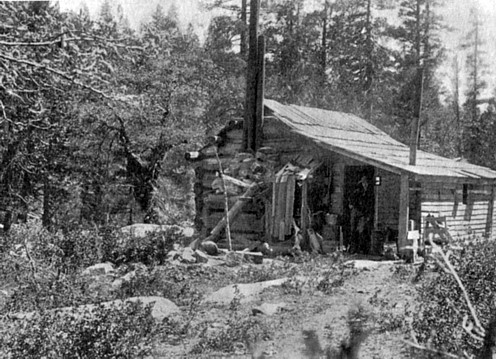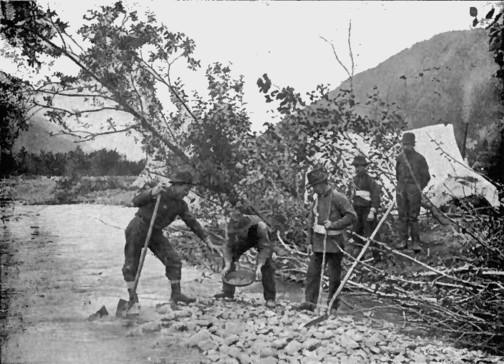The history of beach mining for gold in Oregon began in the spring of 1853, when the discovery of gold in the sand of the sea beach leading to one of those sudden migrations of the mining population expressively termed a “gold rush” The first discovery was made by some mountain men in 1852 at the mouth of a creek a few miles north of the Coquille, near where the town of Randolph appears on the map. The gold was exceedingly fine, the use of a microscope being often necessary to identify it; yet when saved, by amalgamation with mercury, was found to be present in paying quantities. The sand in which it was found existed not only on the modern beach, but on the upper Coquille, forty miles in the interior, at a place known as Johnson Diggings; but the principal deposits were from the Coquille River south along the recent beach to the California line. Gold is found in the beach sand from the surface to the depth of 6 feet or more; it is formed in very small thin scales, and separates from the black sand only with difficulty. Native platinum and the associated platinum group metals, such as iridosmine (an alloy of irridum and osmium), etc., are found with the beach sand gold in large quantities, and as they cannot easily be separated from the gold by washing, and so its value in the market is considerably lessened (in those days platinum was not worth much).
The most important deposits were located where the gold was found is an ancient beach, about 10 miles east or back of the present beach. The gold is concentrated in layers of black sand formed during storms - this is true for both the ancient and recent beach sands. The ancient sand mines are 180 feet above the level of the ocean, which has evidently receded to that extent. The depth of the gold varies from one to twelve feet, there being 12 feet on the ocean side to one foot on what was formerly the shore side. The breadth is from 300 to 500 feet, which is covered with white sand to a depth of 40 feet.
The surface is overgrown with a dense forest, and trees of great size are found in the black sand, in a good state of preservation, which proves that there the beach was at no remote period. Iron is a large component of this black sand, audit would probably pay to work it for that metal now. After the discovery of gold, a mining town called Elizabeth sprang up during the summer about thirty miles south of Port Orford, and another seven miles north of the Coquille, called Randolph City. The latter name may still be found on some maps, but the town has passed out of existence along with hundreds of others. Like most placer deposits, the richest and most productive deposits were mined first. After a few years the output of the beach diggings began to decrease significantly. Although the returns from certain localities were at first flattering, the irregular value of the deposits, and the difficulty of disposing of the gold on account of expense of separation, soon sent most of the miners back to the placer gold nugget diggings of the interior, leaving a few of the less impatient to continue the mining efforts. Small amounts of gold and platinum were produced for many years.
The Native Americans living at the mouth of the Coquille questioned the right of the white men to come in and occupy that region, and added to insolence the potential of robbery and murder. Therefore, on the 28th of January, a party of forty, led by George H. Abbott, went to their village, killed fifteen men, and took prisoners the women and children. Seeing this action, the chiefs of other villages were glad to make peace on any terms, and keep it until driven again to desperation. Superintendent Palmer, in the spring of 1854, began a round of visits to his Native American wards, going by the way of the Rogue River Valley and Crescent City, and proceeding up the coast to Yaquina Bay. Finding the Indians on the southern coast shy and unapproachable, he left at Port Orford Sub-agent Parrish with presents to effect some conciliation. Prominent among matters growing out of beach mining, next after the Indian difficulties, was the more perfect exploration of the Coos Bay country, which resulted from the passing back and forth of supply trains between the Umpqua and the Coquille rivers. Other explorations for gold ore and valuable minerals were at the same time being carried on through out the Southern Oregon region. A trail was opened across the mountains from Rogue River Valley to Crescent City, which competed with the Scottsburg road for the business travel to the interior, and became the route used by the government troops in getting from the seaboard to Fort Lane. Gold hunting was at the same time prosecuted in every part of the Oregon territory with varying success.
Return
to The Oregon History Page:
Oregon Gold Rush History



